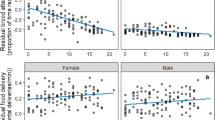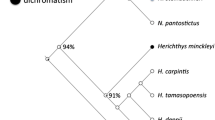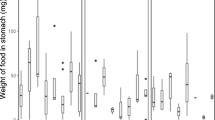Summary
Males were the principal care-givers in the brown bullhead, Ictalurus nebulosus. Direct observations on individually tagged adults in nature revealed that males attended broods at closer distances than females and were the most frequent lone care-givers. However, females often participated in parental care and in some cases assumed the typical male role in the absence of the male. In the presence of her mate, females generally performed different care-giving functions than males. Females attended broods at a distance and chased other fishes more frequently than males. Males remained directly over the brood guarding. A series of mated pairs in each of three reproductive conditions were captured and examined. Different pairs were compared between reproductive conditions for body weight, body condition, gonadal-somatic index, and a gut-contents index. The inital costs of reproduction, as measured by weight loss, condition change, and gonadal-somatic index change, were more severe in females than males. During breeding and subsequent care-giving, males did little or no feeding whereas females increased their feeding during the same time period. However, males appeared to sustain only minor weight and condition losses due to care-giving. I suggest that males were the principal care-givers because the net benefits of remaining at the nest were greater than the net benefits of leaving. Males had little opportunity to mate with more than one female each season, and offspring had little chance of survival in the absence of a care-giving adult. Considerable variation in female behavior occurred which suggests that the net benefits of care-giving were nearly balanced with the net benefits of leaving the brood. The relative importance of feeding versus care-giving by females may vary with slight differences between females and the behavior of their mates as care-givers.
Similar content being viewed by others
References
Alexander RD, Borgia G (1979) On the origin and basis of the male-female phenomenon. In: Blum MS, Blum NA (eds), Sexual selection and reproductive competition in insects. Academic Press, New York (pp 417–440)
Baerends GP, Baerends-van Roon JM (1950) An introduction to the study of the ethology of cichlid fishes. Behaviour (Suppl 1):1–242
Bagenal TB, Tesch FW (1978) Age and growth. In: Bagenal T (ed), Methods for assessment of fish production in fresh waters. Blackwell, London, (pp 101–136)
Barlow GW (1964) Ethology of the Asian teleost Badis badis V. Dynamics of fanning and other parental activities, with comments on the behavior of the larvae and postlarvae. Z Tierpsychol 21:99–123
Barlow GW (1984) Patterns of monogamy among teleost fishes. Arch Fischereiwiss 35:75–123
Baylis JR (1981) The evolution of parental care in fishes, with reference to Darwin's rule of male sexual selection. Environ Biol Fish 6:223–251
Bell G (1984) Measuring the cost of reproduction. I. The correlation structure of the life table of a plankton rotifer. Evolution 38:300–313
Blumer LS (1979) Male parental care in the bony fishes. Q Rev Biol 54:149–161
Blumer LS (1982a) A bibliography and categorization of bony fishes exhibiting parental care. Zool J Linn Soc 75:1–22
Blumer LS (1982b) Parental care and reproductive ecology of the North American catfish, Ictalurus nebulosus. PhD Thesis, Univ. Michigan, 160 pp
Blumer LS (1984) Simple, inexpensive method of tagging Ictalurid fishes for individual identification. Prog Fish-Cult 46:152–154
Blumer LS (1985a) Reproductive natural history of the brown bullhead Ictalurus nebulosus in Michigan. Am Midl Nat 114:318–330
Blumer LS (1985b) The significance of biparental care in the brown bullhead, Ictalurus nebulosus. Environ Biol Fish 12:231–236
Blumer LS (1986) The function of parental care in the brown bullhead, Ictalurus nebulosus. Am Midl Nat (in press)
Borgia G (1979) Sexual selection and the evolution of mating systems. In: Blum MS, Blum NA (eds) Sexual selection and reproductive competition in insects. Academic Press, New York (pp 19–80)
Conover WJ (1971) Practical nonparametric statistics. Wiley, New York (p 462)
Dawkins R, Carlisle TR (1976) Parental investment, mate desertion and a fallacy. Nature 262:131–133
Fryer G, Iles TD (1972) The cichlid fishes of the great lakes of Africa: Their biology and evolution. Oliver and Boyd, Edinburgh (p 641)
Itzkowitz M, Nyby J (1982) Field observations of parental care of the Texas cichlid Cichlasoma cyanoguttatus. Am Midl Nat 108:364–368
Jenni DA (1974) Evolution of polyandry in birds. Am Nat 14:129–144
Keenleyside MHA (1978) Parental care behavior in fishes and birds. In: Reese ES, Lighter FJ (eds) Contrasts in behavior. Wiley, New York (pp 3–29)
Keenleyside MHA, Bietz BF (1981) The reproductive behaviour of Aequidens vittatus (Pisces, Cichlidae) in Surinam, South America. Environ Biol Fish 6:87–94
Kleiman DG (1977) Monogamy in mammals. Q Rev Biol 52:39–69
Lack D (1968) Ecological adaptations for breeding in birds. Methuen, London (p 409)
Loiselle PV (1978) Prevalence of male brood care in teleosts. Nature 276:98
Loiselle PV, Barlow GW (1978) Do fishes like like birds? In: Reese ES, Lighter FJ (eds) Contrasts in behavior. Wiley, New York (pp 31–75)
Maynard Smith J (1977) Parental investment: A prospective analysis. Anim Behav 25:1–9
Moen T (1959) Sexing of channel catfish. Trans Am Fish Soc 88:149
Nelson B (1957) Propagation of channel catfish in Arkansas. Annu Conf SE Assoc Game Fish Comm Proc 10:165–168
Nussbaum RA (1985) The evolution of parental care in salamanders. Misc Publ Mus Zool Univ Mich 169:1–50
Parker GA, Baker RR, Smith VGF (1972) The origin and evolution of gamete dimorphism and the male-female phenomenon. J Theoret Biol 36:529–553
Perrone M, Zaret TM (1979) Parental care patterns of fishes. Am Nat 113:351–361
Ridley M (1978) Paternal care. Anim Behav 26:904–932
Rubec PJ, Qadri SU (1982) Comparative age, growth, and condition of brown bullhead, Ictalurus nebulosus, in sections of the Ottawa River, Canada. Can Field Nat 96:6–18
Tinkle DW, Gibbons JW (1977) The distribution and evolution of viviparity in reptiles. Misc Publ Mus Zool Univ Mich 154:1–55
Trivers RL (1972) Parental investment and sexual selection. In: Campbell B (ed) Sexual selection and the descent of man 1871–1971. Aldine, Chicago (pp 136–179)
Ward JA, Samarakoon JI (1981) Reproductive tactics of the Asian cichlids of the genus Etroplus in Sri Lanka. Environ Biol Fish 6:95–103
Wells KD (1977) The social behaviour of anuran amphibians. Anim Behav 25:666–693
Wells KD (1981) Parental behavior of male and female frogs. In: Alexander RD, Tinkle DW (eds) Natural selection and social behavior. Chiron Press, New York (pp 184–197)
Williams GC (1975) Sex and evolution. Princeton Univ Press, Princeton (p 200)
Wittenberger JF, Tilson RL (1980) The evolution of monogamy: Hypotheses and evidence. Annu Rev Ecol Syst 11:197–232
Author information
Authors and Affiliations
Additional information
Present address: Department of Zoology, Ohio State University, 1735 Neil Avenue, Columbus, Ohio 43210, USA
Rights and permissions
About this article
Cite this article
Blumer, L.S. Parental care sex differences in the brown bullhead, Ictalurus nebulosus (Pisces, Ictaluridae). Behav Ecol Sociobiol 19, 97–104 (1986). https://doi.org/10.1007/BF00299944
Received:
Accepted:
Issue Date:
DOI: https://doi.org/10.1007/BF00299944




